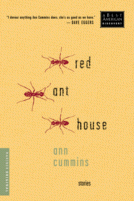Interview With Ann Cummins
Ann Cummins is a graduate of the Johns Hopkins University and the University of Arizona writing programs, Ann Cummins has published stories in The New Yorker, McSweeney's, and The Best American Short Stories 2002, among other publications. The recipient of a Lannan Fellowship, she divides her time between Oakland, California, where she lives with her husband, and Flagstaff, Arizona, where she teaches creative writing at Northern Arizona University. Red Ant House (Houghton Mifflin), Ann Cummins' new short story collection, contains twelve gripping stories which introduce us to intense characters propelled by untamed forces in themselves.
 Click here for ordering information. |
It's titled after the opening story, a story about a young girl who is surrounded by people who barter with other people's secrets. She has an eye for the hidden world: the man down the block who has two families, a secret one and a public one; the bachelor whose appetites lead him into danger and shame. She's cunning and is leaping toward a shady adulthood herself. If she were an insect, she might be a fire ant burning brightly in dark places. The image of the ant house seemed right for this story. It suggests an intricate network of relationships, all hidden underground. The anthill could actually be considered a framing image for the entire collection.
Does the image recur in the collection?
Not so much the image, though there are lots of insects in these stories — blue flies, termites, gnats, ants — but the theme of secrets and secret worlds. My stories are very much character-driven stories. I'm attracted to the wild in human beings — not the psychotic, but the dark, hidden places in all of us. I find stories in those moments when the civilized, driven by desire, passion, fear, begin to misbehave. So an urban housewife has a little bit of a klepto in her; a disgruntled employee slits his boss's tires. Little crimes get played out by characters who have varying relationships with secret, hidden worlds, with the wild in themselves and others.
How and when did you become interested in the secretive as material for fictional characters?
Probably I sensed that there was more to people than met the eye early on, but there was a point in my early twenties when I became painfully conscious that there was a lot more to the world than my limited experience allowed me to see. I grew up on the Navajo Indian reservation. The Vanadium Corporation of America had a uranium mill in Shiprock, a small community in the northeastern corner of the reservation. My dad was a shift foreman. I had a great life on the reservation. I loved the desert, had good friends. Then I went to college at the University of Oregon, took a Navajo folklore class from Barre Tolkien, and was introduced to a place I'd never been — the place where I grew up. Subliminally, I must've known that there were undercurrents on the reservation, that not everybody was happy with the apartheid-like life we all lived. I was in public schools there. There were few Navajo teachers; kids were punished for speaking Navajo in school. The readers were your Dick and Jane variety; the history books, battles between Davy Crocket and "savages." Though the public schools were integrated, the mill workers — whites who had been transferred from a mill in Colorado — lived in a compound cordoned off by a barbed-wire fence. I was astounded by what I learned in that folklore class about Navajo customs, religion, history — especially the history of a culture undermined. I couldn't reconcile it with my own experience of the reservation. I began writing because I wanted to express what I had learned. But my early attempts were frustrating. I couldn't trust myself to get it "right." I had begun to perceive a layer of experience and custom — others' experiences and customs — that complicated my memories. I kept running into roadblocks in my writing. What, I wondered, if there are more layers behind these? This led me to be suspicious of declarative sentences and polemics.
So you turned to fiction?
I turned to doodling, and that turned into fiction. I had a memory in my head of a pregnant girl, a Navajo teenager whom I saw one day turning cartwheels across the high school cafeteria floor. She looked frustrated and driven. The image burned itself in my mind, and I tried describing it, the girl's grace and her frustration, the external and the internal. The image took on flesh, a story took hold, and things began to happen. The story turned into an early version of "Trapeze," the second story in the collection.
"Things began to happen"? Is that how you write short stories? You let things happen?
Yes and no. For me, writing fiction is an endless exercise in revisiting — no, reliving character. Letting things happen means becoming enrapt in make-believe characters the way a child would — to have invisible friends (and enemies) — and then to believe in them the way a child does — completely. Such characters don't lie, and, whether consciously or unconsciously, they reveal their secret worlds. But a child's fantasies tend to be episodic": . . . and then this happened, and then this, and then . . . this" That won't do for short stories. Jorge Borges said that in a short story, as in a poem, every word is essential. A high bar to reach, that kind of precision, but one, I think, that's utterly worth trying for.
Posted with permission of the publisher.
